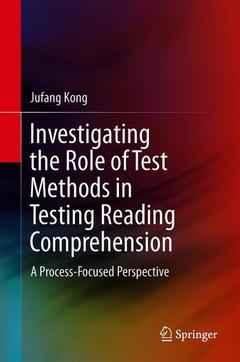Description
Investigating the Role of Test Methods in Testing Reading Comprehension, 1st ed. 2019
A Process-Focused Perspective
Author: Kong Jufang
Language: English
Subject for Investigating the Role of Test Methods in Testing...:
Approximative price 105.49 €
In Print (Delivery period: 15 days).
Add to cart
Publication date: 04-2019
Support: Print on demand
Support: Print on demand
Description
/li>Contents
/li>Biography
/li>Comment
/li>
This book explores the construct of reading comprehension by means of two main test methods. Research methods like the think aloud protocol and eye tracking are employed to tap into test-takers? cognitive processes while engaged in input text meaning building, and in test tasks. The book is the first systematic attempt to explore test-takers? cognitive processes through the control of test methods, and presents findings in visualized form including processing route maps and eye fixation heat maps. It offers readers essential support with ?digging into? and analyzing data that has to date remained difficult to access.
Part One
Chapter One Introduction
1.1 Research Background
1.2 Research Focus
1.3 Book Structure
1.4 Summary
Chapter Two Theories of Reading Comprehension
2.1 Nature of Reading Comprehension
2.1.1 Psycholinguistic Perspective of Reading Comprehension
2.1.2 Cognitive Perspective of Reading Comprehension
2.1.3 Processing Patterns of Reading Comprehension
2.1.3.1 Bottom-up Processing
2.1.3.2 Top-down Processing
2.1.3.3 Interactive Processing
2.2 Factors Involved in Reading Comprehension
2.2.1 Reader
2.2.2 Text
2.2.3 Interaction
2.2.3.1 Purpose of Reading Comprehension
2.2.3.2 Skills
2.2.3.3 Strategies and Metacognitive Strategies
2.3 Khalifa and Weir’ Model of Reading Comprehension
2.4 Summary
Chapter Three Construct and Validity
3.1 Construct
3.1.1 A Trait Theorist View
3.1.2 A Behaviourist View
3.1.3 An Interactionalist View
3.2 Validity
3.3 Validation
3.3.1 Messick’s Validation Framework
3.3.2 Kane’s Interpretive Argument Framework
3.3.3 Bachman and Palmer’s AUA Framework
3.3.4 Campbell and Fiske’s MTMM Approach
3.4 A Process-focused Construct Validation Framework
3.5 Summary
Chapter Four Test Method and Response Format
4.1 Test Method
4.2 Response Format
4.2.1 Response Formats Most Commonly Used in Reading Comprehension Tests
4.2.1.1 MCQ Format
4.2.1.2 SAQ Format
4.2.2 Response Format Effect(s) on Test takers’ Reading Comprehension Per-formances
4.3 SummaryChapter Five Methodology
5.1 Quantitative Approach
5.2 Qualitative Approach
5.3 Mixed Methods Approach
5.4 A Qualitative Dominant Mixed Methods Approach
5.5 Summary
Part Two
Chapter Six Quantitative Strand
6.1 Research Design
6.1.1 Research Procedures
6.1.2 Participants
6.1.3 Research Instruments
6.2 Findings
6.2.1 Descriptive Statistics
6.2.1.1 Item Statistics
6.2.1.2 Passage Statistics
6.2.1.3 Total Score Statistics
6.2.2 Inferential Statistics
6.2.2.1 Paired-sample T-test
6.2.2.2 MTMM CFA
6.2.3 Summary of Findings
6.3 SummaryChapter Seven Employing Think Aloud Protocols (TAPs) to Explore Test takers’ Cognitive Processes
7.1 TAPs Paradigm
7.1.1 Rationale and Concerns of TAPs
7.1.2 TAPs in Reading Research
7.1.3 TAPs in Language Testing and Assessment
7.2 Research Design
7.2.1 Research Procedures
7.2.1.1 Pilot Study
7.2.1.2 Formal Data Collection
7.2.1.3 TAPs Data Transcription and Coding
7.2.1.4 Cognitive Process Route Map
7.3 Findings
7.3.1 Test Level Analysis
7.3.2 Question Type Level Analysis
7.3.2.1 Question Type 1 TAPs Data Analysis
7.3.2.2 Question Type 2 TAPs Data Analysis
7.3.2.3 Question Type 3 TAPs Data Analysis
7.3.2.4 Question Type 4 TAPs Data Analysis
7.3.2.5 Question Type 5 TAPs Data Analysis
7.4 Summary of Findings
7.5 SummaryChapter Eight Employing Eye Tracking to Explore Test takers’ Cognitive Processes
8.1 ET Paradigm
8.1.1 Rationale and Concerns of ET
8.1.2 ET in Reading Research
8.1.3 ET in Language Testing and Assessment
8.2 Research Design
8.2.1 Research Procedures8.2.1.1 Research Instruments
8.2.1.2 Pilot Study
8.2.1.3 Participants
8.2.1.4 Formal Data Collection
8.3 Findings
8.3.1 Test Level Analysis
8.3.2 Question Type Level Analysis
8.3.2.1 Question Type 1 ET Data Analysis
8.3.2.2 Question Type 2 ET Data Analysis
8.3.2.3 Question Type 3 ET Data Analysis
8.3.2.4 Question Type 4 ET Data Analysis
8.3.2.5 Question Type 5 ET Data Analysis
8.4 Summary of the Findings
8.5 Summary
Chapter Nine Conclusion and Future Directions
9.1 Major Findings
9.2 Implications
9.2.1 Test Validation
9.2.2 Construct of Reading Comprehension Competence
9.2.3 Reading Comprehension Test Development
9.2.4 TAPs in Research on Cognitive Processing
9.2.5 ET in Research on Language Testing and Assessment
9.3 Limitations
9.4 Future Directions
9.5 Summary
Dr. Jufang Kong is a lecturer and Dean of the Teaching Research section of the College of Foreign Languages at Zhejiang Normal University, China. She holds a PhD in Language Testing and Assessment from Shanghai International Studies University and was a visiting student at the School of Education, University of Leicester, during her PhD studies. Her research interests include assessing reading skills, language test validation and assessing young language learners. In 2017, she received approval for the Ministry of Education Humanities and Social Sciences Project.
Explores the prospect of a process-focused paradigm in language testing research
Sheds light on the “dark box” of test-takers’ cognitive processing to expand readers’ previous knowledge
Provides valuable new insights into the construct of reading comprehension
© 2024 LAVOISIER S.A.S.




